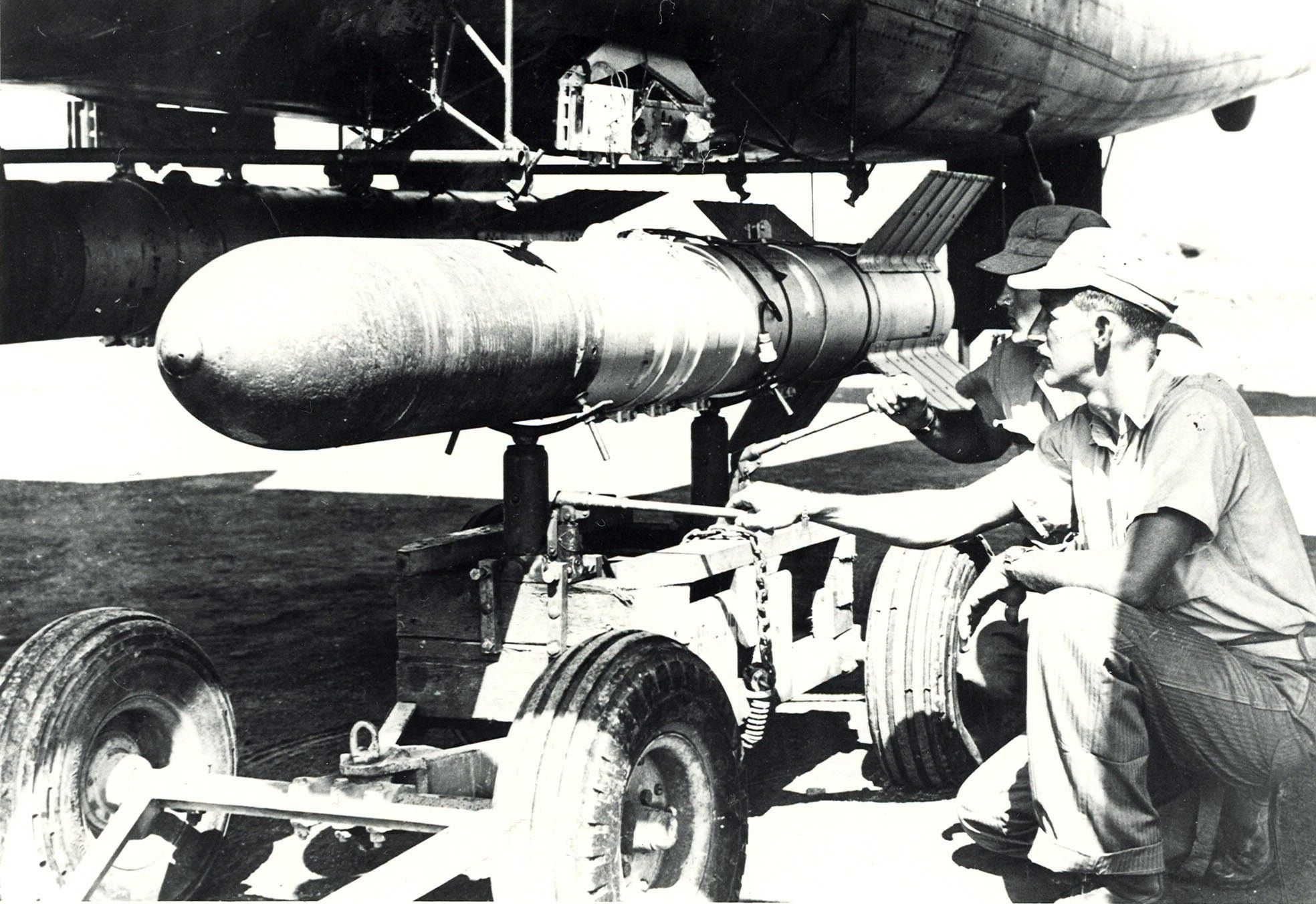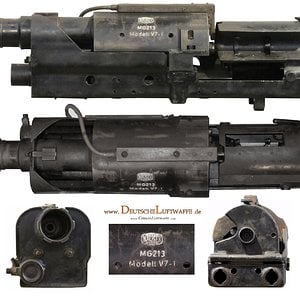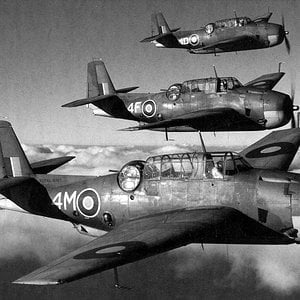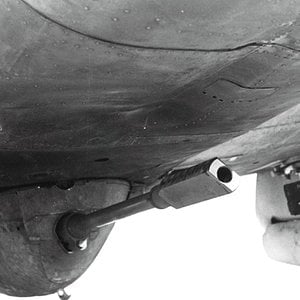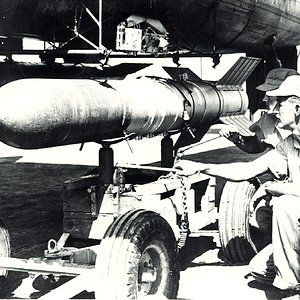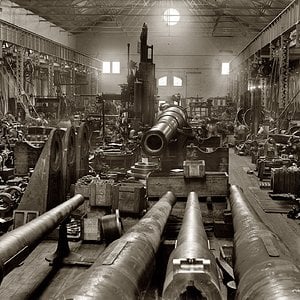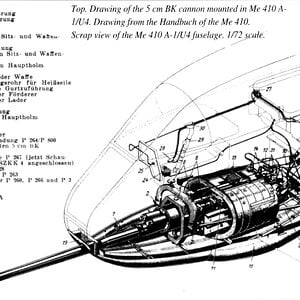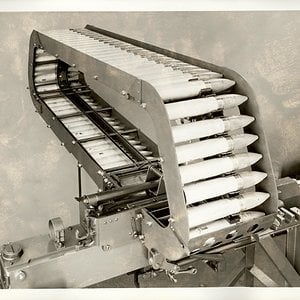Navigation
Install the app
How to install the app on iOS
Follow along with the video below to see how to install our site as a web app on your home screen.
Note: This feature may not be available in some browsers.
More options
You are using an out of date browser. It may not display this or other websites correctly.
You should upgrade or use an alternative browser.
You should upgrade or use an alternative browser.
Loading a Tiny Tim on PBJ Mitchell
Ship-to-ship missile Tiny Tim is loaded on to a PBJ Mitchell belonging to Squadron VMB-612, United States Marine Corps on the island of Iwo Jima August 1945.
Launch of "Tiny Tim" developed by the California Institute of technology, adopted in 1945, mass of 580 kg (1.280 pounds), flight speed 1.480 km/h (810 ft/s). Was used at the very end of the second world war at the battle of Okinawa.
The Tiny Tim was an American air to ground rocket used near the end of the Second World War. One source states it was built in response to a US Navy requirement for an anti-shipping rocket capable of hitting ships outside of their anti-aircraft range, with a payload capable of sinking heavy shipping. However, according to the China Lake Weapons Digest, the Tiny Tim was
designed by the Caltech-China Lake team as a bunker-buster, Tim was the first large aircraft rocket, and, although it saw only limited service in WWII, it helped form the foundations of many postwar developments in rocketry.
For a warhead, Tiny Tim utilized a 500 lb semi-armor-piercing high explosive bomb. It had a maximum range of 1,500 meters (1,640 yards).
They were used by the US Navy and US Marine Corps near the end of the war during the battle of Okinawa, and during the Korean war. A problem with the sheer power of the rocket motor causing damage to the firing aircraft was resolved by having the Tiny Tim drop like a bomb, and a lanyard attached to the rocket would snap, causing the rocket to ignite . Common targets included coastal defense guns, bridges, pill boxes, tanks, and shipping. An ambitious operation to use the Tiny Tim against German V-1 sites as part of Operation Crossbow, code-named Project Danny, was planned but cancelled before the squadrons assigned could be deployed to Europe.
Common Tiny Tim delivery aircraft during the Second World War included the F4U Corsair, F6F Hellcat, TBM Avenger, and the SB2C Helldiver.
After World War Two the US Navy's rocket laboratory at Inyokern, California developed an even larger version of the Tiny Tim, called "Richard", which was 14 inches in diameter and most likely the largest air to surface unguided rocket ever developed for the US military. While tested, it was never placed in production. The US Navy also experimented with a version of the Tiny Tim which was a two-stage rocket, with another Tiny Tim rocket motor mounted behind a complete Tiny Tim. Like the Richard it never moved beyond the R&D stage
Ship-to-ship missile Tiny Tim is loaded on to a PBJ Mitchell belonging to Squadron VMB-612, United States Marine Corps on the island of Iwo Jima August 1945.
Launch of "Tiny Tim" developed by the California Institute of technology, adopted in 1945, mass of 580 kg (1.280 pounds), flight speed 1.480 km/h (810 ft/s). Was used at the very end of the second world war at the battle of Okinawa.
The Tiny Tim was an American air to ground rocket used near the end of the Second World War. One source states it was built in response to a US Navy requirement for an anti-shipping rocket capable of hitting ships outside of their anti-aircraft range, with a payload capable of sinking heavy shipping. However, according to the China Lake Weapons Digest, the Tiny Tim was
designed by the Caltech-China Lake team as a bunker-buster, Tim was the first large aircraft rocket, and, although it saw only limited service in WWII, it helped form the foundations of many postwar developments in rocketry.
For a warhead, Tiny Tim utilized a 500 lb semi-armor-piercing high explosive bomb. It had a maximum range of 1,500 meters (1,640 yards).
They were used by the US Navy and US Marine Corps near the end of the war during the battle of Okinawa, and during the Korean war. A problem with the sheer power of the rocket motor causing damage to the firing aircraft was resolved by having the Tiny Tim drop like a bomb, and a lanyard attached to the rocket would snap, causing the rocket to ignite . Common targets included coastal defense guns, bridges, pill boxes, tanks, and shipping. An ambitious operation to use the Tiny Tim against German V-1 sites as part of Operation Crossbow, code-named Project Danny, was planned but cancelled before the squadrons assigned could be deployed to Europe.
Common Tiny Tim delivery aircraft during the Second World War included the F4U Corsair, F6F Hellcat, TBM Avenger, and the SB2C Helldiver.
After World War Two the US Navy's rocket laboratory at Inyokern, California developed an even larger version of the Tiny Tim, called "Richard", which was 14 inches in diameter and most likely the largest air to surface unguided rocket ever developed for the US military. While tested, it was never placed in production. The US Navy also experimented with a version of the Tiny Tim which was a two-stage rocket, with another Tiny Tim rocket motor mounted behind a complete Tiny Tim. Like the Richard it never moved beyond the R&D stage

